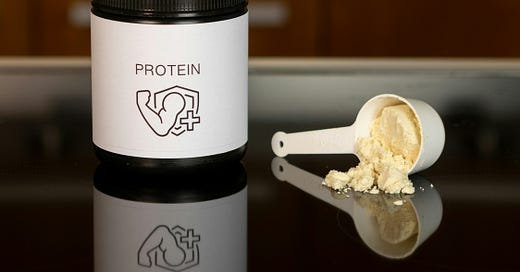Post summary
Protein is having a moment.
The protein market will nearly double in the next 25 years, and more manufacturers are marketing “high protein” foods.
Protein is a critical part of the human diet.
But are we overselling the importance of protein? Are we “overdoing” protein? And if we are, does that come with downsides?
This is part one of a two-part guide to protein.
You’ll learn the the truth about nine different topics in protein, ranging from whether we get enough protein and how much of it we should eat, to whether protein elevates our metabolism and just how important protein is for fat loss and muscle growth.
Housekeeping
Full access to this post is for Members of Two Percent. Become a Member to get full access to this post and all Two Percent posts and their audio versions:
Partnered with:
Eight Sleep
Sleeping in cooler temperatures seems to universally improve sleep. Yet it isn’t always easy to sleep cool because of our warm modern homes and hot modern mattresses. Eight Sleep cools your mattress’ temperature to whatever is ideal for you—improving your sleep and health. Use EASTER at Eight Sleep for a discount.Jaspr Air Purifiers
I use a Jaspr in my home and think it’s one of the easiest things you can do to improve your health—just plug it in and remember to breathe. Air quality is highly linked to health. Having a Jaspr in my room improved my sleep and I love watching the Jaspr in our kitchen kick on and filter our air after my frequent cooking disasters. Get a discount through this link.
GOREWEAR
GOREWEAR designs endurance gear for Two Percenters. Their products are tailored for athletes and optimized to help you perform in any weather. GOREWEAR leverages the most cutting-edge science and works. No matter how hard we train or what Earth throws at us. Use code EASTER30 for 30% off your next order. Discover more at www.gorewear.com.
Audio/podcast version
The post
Against better judgment, I recently found myself in the black hole that is Twitter.com.
I follow rational, wise health scientists, but the algorithm prefers engagement and extremes.
That’s how I came across a post from a fitness influencer showing his go-to gas station snack. It was as follows:
Two bottles of Fairlife Core Power protein milkshake.
One stick of beef jerky.
One Quest protein bar.
The magic, he wrote, was in the protein—120+ grams and minimal carbs or fat.
He explained that all this protein was conjuring up many benefits: elevating his metabolism, killing his hunger, building his muscle, melting fat, blah, blah. You get the point.
The nutrition world is a flat circle, where eating this thing or that rises and falls with the passage of time, novelty, and attention.
If my algorithms are any indication, we’re deep in the protein phase of the flat circle.
The global protein market is booming and will hit $50 billion by 2028.
60 percent of Americans are actively trying to eat more protein.
Food corporations are cashing in on high-protein versions of their normal packaged foods.
This post is part one of a two-post series covering the truth about protein. Today you’ll learn:
Whether the standard American diet gives us “enough” protein.
How much protein we should eat.
If you can eat too much protein.
How important protein is for muscle growth.
If protein helps us lose weight.
If there are longevity benefits to eating less protein.
If protein elevates your metabolism.
If protein is more filling compared to other foods.
When we need protein the most.
Part two (publishing Monday) will cover practical topics in protein, like plant vs. animal proteins, the truth about protein bars and powders, strategies to get more protein, and more.
Consider this two-part series a dose of sanity sauce. Read on to learn whether that sauce should contain protein.
Does a standard American diet give us “enough” protein?
Section summary: Yes, the average diet probably gives us enough protein.
America eats more protein than any other country. The average man and woman eat about 100 and 80 grams a day, respectively. Much of our protein comes from meat, of which we each consume about 200 pounds annually.
The government sets the recommended daily allowance (RDA) of protein at .36 grams per pound of your body weight.
For example, that’s about 72 grams of protein a day if you weigh 200 pounds and 50 grams if you weigh 140 pounds.
It’s rather hard not to get that much protein unless you’re cutting your calories or avoiding animal products. Most people get well beyond the RDA without trying.
Protein makes up about 15 to 18 percent of the average American diet, and most Americans eat anywhere from 2,500 to 3,000 calories daily. Do the math, and you have significantly more than the RDA.
Some nutrition researchers think the protein RDA is too low (more on that below), but others point out that the RDA contains a built-in buffer to meet and/or exceed the protein requirements of the population.
“If everyone were to get the RDA, almost no one would be deficient,” said Christopher Gardner, a Stanford nutrition professor.
How much protein should we eat?
Section summary: It depends on your goals. Most Americans who eat animal products probably get “enough” protein for general health. But you may want to eat more if you’re highly active, trying to lose weight or gain muscle, or aging or pregnant.
Stu Phillips, one of the world’s top protein researchers, thinks the RDA should be considered the MRA, or “minimum daily allowance.”
He believes people should get at least .5 grams per pound of their body weight. Most Americans do get roughly this amount.
But in some situations—like if you want to gain muscle or lose fat, or if you’re aging or pregnant—you might want to eat more. Here’s how much:




